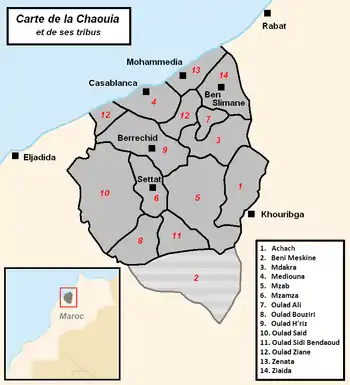Chaouia (Morocco)
Chaouia (Arabic: الشاوية) is a historical and ethno-geographical region of Morocco. It is bounded by the Oum Er-Rbia River to its southwest, the oued Cherrate to its northeast, the plain of Tadla to the southeast and the Atlantic Ocean to the northwest. The enclave covers a land area of nearly 14 000 km2.

Geographically, the Chaouia can be divided into two sub-regions: low and high. The low Chaouia being the coastal part while the high Chaouia is further inland. Soils vary in fertility: The dark tirs is prized for its high yields and is found among the Mdhakra, Ouled Hriz and Oulad said. There is also the red hamri terra rossa.
Throughout Morocco's history, the Chaouia was famous for farming wheat and barley, which were exported in years of abundance from Casablanca, Fédala or Azemmour. Chaouia sheep was also prized for its wool, which was also exported to Marseille where it was known as wardigha in reference to one of the tribes in the interior.
Nowadays, the Chaouia is part of the Casablanca-Settat administrative region.[1][2][3]
History
The Chaouia was part of the Barghawata territory until being unified to Morocco by Almoravids.[5]
Following the defeat of the Barghawata in the 12th century, Arab tribes of Hilal and Sulaym descent were settled in the region, mixing with and Arabicizing the local Berbers.[5] In the 13th and 14th centuries, Marinids moved some Zenata Berbers from Eastern Morocco to the Chaouia.
In the early 20th century, the Chaouia experienced a strong rebellion.[6] In 1907, the French entered the region before extending their control over all Morocco.[7]

During the French protectorate, the Chaouia was part of the "Autonomous subdivision of Casablanca". It was then divided into three civilians controls : Chaouia-North (Casablanca) Chaouia-Center (Berrechid) and Chaouia-South (Settat).
Tribal composition
The Chaouia tribal confederacy is traditionally consisting of 14 Arabic-speaking tribes:
- Achach, of Sulaym Arab origin.[8]:157–190
- Beni Meskine, of Arab origin, having previously been part of the Tadla confederacy, joined the Chaouia confederacy in the 19th century.
- Mdakra, partially of Arab origin (Ahlaf and Sabbah subtribes), and partially of Houara Berber origin (Mellila subtribe), having merged with a Barghawata original group.[8]:117–156
- Mediouna, of Zenata Berber origin.[8]:15–23
- Mzab, mainly of Zenata Berber origin.[8]:157–190
- Mzamza, mainly of Masmouda Berber origin, with a significant Jochem Arab affluent.[8]:243–320
- Oulad Ali, of Maqil Arab origin.[8]:117–156
- Oulad Bouziri, of Sanhaja Berber origin.[8]:243–320
- Oulad Hriz, mainly of Arab origin, with a few subtribes of Berber origin.[8]:71–116
- Oulad Saïd, of Zughba Arab origin, settled in the region during the Marinid era.[8]:191–242
- Oulad Sidi Bendaoud, mainly of Sanhaja Berber origin.[8]:243–320
- Oulad Ziane, of Zughba Arab origin.[8]:24–29
- Zenata, of Zenata Berber origin.[8]:30–44
- Ziaïda, mainly of Sanhaja Berber origin ; it assimilated the Beni Oura tribe by the end of the 19th century.[8]:45–70
References
- "Chaouia", on Encyclopédie Universalis
- J.F. Troin & M. Berriane, Les espaces satellites de Casablanca : Chaouia et Doukkala, in Maroc : régions, pays, territoires, 2002, pp.71-86 (ISBN 2-7068-1630-9)
- E. Lapeyre & E. Marchand, Casablanca, la Chaouia, 1918 (N. 2 43-120-3)
- « Ce terme pluriel "Chaoui", signifie possesseurs de troupeaux de moutons. A l'origine, il servait vraisemblablement à désigner les Berbères nomades et tant que l'on tint compte de son étymologie – ainsi que semble l'avoir fait Ibn Khaldoun – le nom de Chaouia ne paraît pas avoir été donné indistinctement à toutes les tribus du Tamsna, mais seulement à celles purement pastorales des steppes de l'intérieur auxquelles il s'appliquait mieux qu'à la population déjà en partie agricole de la plaine littorale. Par la suite, ce qualificatif devint un véritable nom ethnique et sa signification première tomba dans l'oubli » - F. Weisberger (1935), via M. Belmir, Le Dr F. Weisgerber sur les pistes des Chaouia, dans liberation.ma (1st Oct. 2014)
- S. Lévy, Pour une histoire linguistique du Maroc, in Peuplement et arabisation au Maghreb occidental: dialectologie et histoire, 1998, pp.11-26 (ISBN 84-86839-85-8)
- E. Burke, Mouvements sociaux et mouvements de résistance au Maroc: la grande siba de la Chaouia (1903-1907), dans Hesperis Tamuda Rabat, vol.17, 1976, pp.149-163
- J. Augarde, Le général d'Amade pacificateur de la Chaouia, in Revue historique de l'armée, n°166, 1987, pp.24-32 (ISSN 0035-3299)
- Mission Scientifique du Maroc (coll.), Villes et Tribus du Maroc: Casablanca et les Chaouïa, Tome II, Ed. E. Leroux (Paris), 1915
Bibliography
- F. Weisberger, Casablanca et les Chaouia en 1900, Ed. Impr. Réunies (Casablanca), 1935
- E. Marchand, Casablanca, la Chaouia, Ed. Larose (Paris), 1918